Welsh art
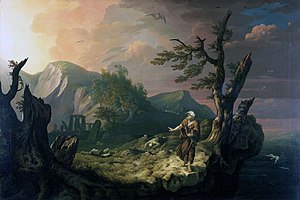
Welsh art is the traditions in the
Early history
Many works of
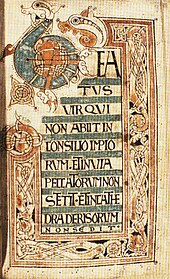
In the
There are only fragments of the architecture of the period remaining. Unlike Irish
Wales has rarely been very prosperous, and the most striking medieval architecture is military, often built by the Normans and English, especially the famous "
The Renaissance in Wales
Peter Lord suggests that the Renaissance began in Wales around 1400.[7] Much of the art produced in this period was created in or for the church. Strata Florida Abbey, for example, retains some of its medieval decorated tiles.[8]
Despite the widespread destruction that took place during the Reformation and later the Commonwealth, a number of Welsh churches retain fragments of medieval
Fifteenth-century wall paintings have been uncovered in several Welsh church buildings, including St Cadoc's Church,

Plas Mawr, a grand Elizabethan town-house in Conwy, built by Robert Wynn, a local man who had been English ambassador to the Holy Roman Emperor, has been extensively restored by Cadw, both inside and out, to reflect its appearance when built in the second half of the sixteenth century.[14] Wales has numerous country houses from all periods after the Elizabethan, many still containing good portraits, but these were mostly painted in London or on the Continent.[15]
Portraiture
Within Wales,
Later, artisan painters such as
Landscapes

The best of the few Welsh artists of the 16th to 18th centuries tended to move elsewhere to work, but in the 18th century the dominance of
Wilson's pupil Thomas Jones (1742–1803), has a rather higher status today than in his own time, but mainly for his city scenes painted in Italy, though his The Bard (1774, Cardiff) is a classic work showing the emerging combination of the Celtic Revival and Romanticism.[21] He returned to live in Wales on inheriting the family estate, but largely stopped painting. For most visiting artists the main attraction was dramatic mountain scenery, in the new taste for the sublime partly stimulated by Edmund Burke's A Philosophical Enquiry into the Origin of Our Ideas of the Sublime and Beautiful (1757), though some earlier works were painted in Wales in this strain.[22] Early works tended to see the Welsh mountains through the prism of the 17th century Italianate "wild" landscapes of Salvator Rosa and Gaspard Dughet.[23]

By the 1770s a number of guide books had been published, including Joseph Cradock's Letters from Snowdon (1770) and An Account of Some of the Most Romantic Parts of North Wales (1777).
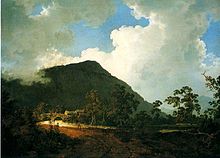
What might fifty years earlier have been merely regarded as inconvenience in travel could now be seen as an exciting adventure worth making the subject of a painting, as in
North Wales tended to be more visited; the young
The French Revolutionary and
Expansion
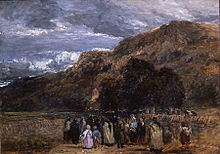
It remained difficult for artists relying on the Welsh market to support themselves until well into the 20th century. The 1851 census records only 136 people describing their occupation as "artist" out of a population of 945,000, with a further 50 engaged in
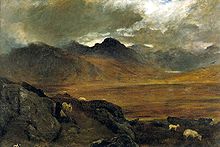
Graduates of the new fine arts Welsh colleges still very often had to leave Wales to work. Established artists continued to move in the opposite direction, at least for the summer.
Perhaps the most famous Welsh-born painters were
The situation gradually improved after World War II, with the appearance of new art groups. The South Wales Group was established in 1948 (and continues today as The Welsh Group with membership from across Wales).[37][38][39][40] The group's initial conception was in response to the Royal Cambrian Academy's relatively weak representation from south Wales at the time. In 1956 when the South Wales Group failed to become a southern Academy, the 56 Group Wales also emerged,[41] with the aim of promoting modern Welsh art beyond Wales' borders.[42] Also in the industrial valleys the
Decorative arts
South Wales had several notable potteries in the late 18th and 19th centuries, beginning with the
Despite the fact that considerable quantities of silver (in association with lead), and much smaller amounts of gold, were mined in Wales, there was little silversmithing in Wales in the Early Modern period. It did not help that the Crown gave itself ownership of mines of precious metals, which were largely used for minting currency, some of which was marked with the Prince of Wales's feathers to show its origin. The Welsh gentry mostly had their silver made in English cities.
Arts and Crafts Movement

The Arts and Crafts movement (c. 1880–1920), with its devotion to the local, gave spark to the development of conceptually independent and identifiable Welsh art. Two elements of the movement were particularly amenable to the Welsh arts situation. First, the movement aspired to elevate the applied arts (pottery, furniture, etcetera) to the status of fine art.[46] Second, the development of Romantic nationalism, which drew from the Arts and Crafts Movement via its "advocacy of indigenous design, traditional ways of making objects, and the use of local materials."[47]
In Wales, at least until World War I, a genuine craft tradition still existed. Local materials, stone or clay, continued to be used as a matter of course.
A key promoter of the Arts and Crafts movement in Wales was Owen Morgan Edwards. Edwards was a reforming politician dedicated to renewing Welsh pride by exposing its people to their own language and history. For Edwards, "There is nothing that Wales requires more than an education in the arts and crafts."[50]—though Edwards was more inclined to resurrecting Welsh Nationalism than admiring glazes or rustic integrity.[51]
In architecture, Clough Williams-Ellis sought to renew interest in ancient building, reviving "rammed earth" or pisé[2] construction in Britain. In 1925, In 1925 he began "his most famous creation, the village of Portmeirion, Merioneth, Wales, a Picturesque composition of individual buildings incorporating Classical details, salvaged fragments, and vernacular elements."[52] His daughter, Susan Williams-Ellis, would found the Portmeirion Pottery in the next generation (although none of this was ever made in Wales).
Contemporary Welsh Art
Today Welsh and Wales based artists, including members of
Conceptual art in Wales
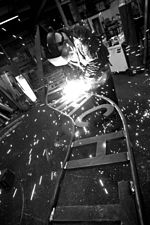
Conceptual art is represented in Wales with a number of successful artists including Bedwyr Williams and David Garner together with performance artists like the group TRACE,[54][55] creating and showing work in Wales and beyond. A number of Welsh galleries focus on conceptual art, with the most significant perhaps being Mostyn[56] in north Wales and Chapter Arts Centre and g|39[57] in south Wales. The Gold Medal at 'Y Lle Celf' in the National Eisteddfod of Wales has seen a notable trend towards more conceptual approaches over the last ten or so years, with Installation work being the usual focal point.[58] The 2003 development of the Artes Mundi prize and Wales's presence at the Venice Biennale has strengthened the country's international reputation for Conceptual and Installation art.
Artes Mundi and Wales at the Venice Biennale
Since 2003 the Artes Mundi biennial art prize has been held at the National Museum Cardiff. The prize is the biggest art prize in the United Kingdom with £40,000 for each year's winner.[59] Though the prize has included artists who use traditional media, like paint, this is usually only part of their practice, with the focus being very much on conceptual approaches. Though the exhibition takes place in Cardiff, the focus is on international artists,[60][61][62] with Tim Davies from Pembrokeshire [63] and Cornwall born Sue Williams[64] being the only Wales based artists to have featured to date.
Also adding to the international flavour in 2003, Wales took part in the Venice Biennale with its own pavilion[65][66] and has continued to do so ever since, showing work by conceptual Welsh artists including John Cale in 2009,[67] Tim Davies in 2011[68] and Bedwyr Williams in 2013.[69]
Welsh artists
| Part of a series on the |
| Culture of Wales |
|---|
 |
| People |
|
Art |
A selected list; for many more, see Category:Welsh artists or List of Welsh artists
- Barry Flanagan, (1941–2009), sculptor
- John Gibson, (1790–1866), sculptor
- Nina Hamnett (1890–1956), painter
- Augustus John (1878–1961), painter
- Gwen John (1876–1939), painter
- Sir William Goscombe John (1860–1952), sculptor
- David Jones(1895–1974), artist and poet
- Thomas Jones (1742–1803), painter
- Ceri Richards (1903–1971), painter
- Andrew Vicari (1938-2016), painter
- Kyffin Williams (1918–2006), painter
- Richard Wilson (1714–1782), painter
See also
- Architecture of Wales
- Arts Council of Wales
- National Museum of Wales
- Welsh Artist of the Year
- Art in Cardiff
- Art of the United Kingdom
- Celtic art
- Irish art
- Scottish art
- Welsh Eisteddfod Gold Medal winners
References
- ^ Houseley explores the lack of a clear sense of "Welsh art" among contemporary artists and in Wales generally. See also Morgan, 371–372.
- ^ Kendrick's Cave BM touring exhibition, BM Highlights
- ^ "Carving found in Gower cave could be oldest rock art", BBC News online, South-West Wales, July 25, 2011
- ^ "Celtic Art in Iron Age Wales". National Museum of Wales. 3 May 2007. Retrieved 30 August 2011.
- ^ "Stunning ironwork firedog uncovered in farmers field". National Museum of Wales. 4 May 2007. Retrieved 30 August 2011.
- ^ "Exquisite Roman treasure gives up its secrets". National Museum of Wales. 9 September 2007. Archived from the original on 10 August 2011. Retrieved 30 August 2011.
- ^ "Art historian Peter Lord talks The Tradition: A New History of Welsh Art: "It's a book for everyone" ", South Wales Evening Post, 7 March 2016. Accessed 3 April 2016
- ^ "Strata Florida Abbey". Cadw. Retrieved 17 May 2016.
- ^ "Medieval fragments". Stained Glass in Wales. Retrieved 17 May 2016.
- ^ "Welsh church uncovers stunning medieval wall paintings", BBC News, 6 December 2013. Accessed 3 April 2016
- ^ Llantwit Major Historical Society. "St. Illtud's Church". Retrieved 27 February 2014.
- ^ Tom Organ, "Reconstructing Medieval Wall Paintings at St Teilo's", www.building.conservation.com. Accessed 3 April 2016
- ^ Claire Miller (28 March 2013). "'Mind-blowing' medieval art is unveiled in church". WalesOnline. Retrieved 17 May 2016.
- ^ Cadw: Plas Mawr. Accessed 3 April 2016
- ^ ""Faces of Wales" from the National Museum of Wales". Archived from the original on 2013-05-13. Retrieved 2010-02-27.
- ^ National Museum of Wales: Katheryn of Berain. Accessed 2 April 2016
- ^ British Listed Buildings: Plas Clough, Denbigh. Accessed 3 April 2016
- ^ National Museum of Wales – William Herbert, 1st Earl of Pembroke. Accessed 3 April 2016
- ^ National Library of Wales: Paintings and Drawings. Accessed 18 April 2016
- ^ Art Collections Online: Hugh Hughes. National Museum of Wales. Accessed 18 April 2016
- ^ NMOW, Welsh Artists of the 18th Century. Though mainly known as a portraitist, John Downman, born and died in Wales, is also noted for unusually realistic Italian townscape studies, and some Welsh landscapes.
- ^ Rosenthal, 52–64
- ^ Rosenthal, 56
- ^ Rosenthal, 61
- ^ Rosenthal, 52 & 54. Image of Phaeton in a Thunderstorm Archived 2016-03-03 at the Wayback Machine
- ^ Holcomb, 8
- ^ Wigstead, Henry (1800). Remarks on a Tour to North and South Wales: In the Year 1797. W. Wigstead.
- doi:10.1093/ref:odnb/24221. (Subscription or UK public library membershiprequired.)
- ^ Wilton & Lyles, 326-7
- ^ Wilton & Lyles, pp. 176 & 260. Respectively: Private Collection, Mellon Centre for British Art, Tate.
- ISBN 978-0-7083-1298-8
- ^ 1855, Table p. xxii
- ^ 1855, Appendix A, pp. 21–26
- ^ 1855, pp. xxii–xxx
- ^ "Royal Cambrian Academy".
- ^ "National Museum of Wales, Walden". Archived from the original on 2014-01-06. Retrieved 2010-02-27.
- ^ [1] The Welsh Group website. Retrieved 2015-01-20.
- ^ Karen Price, "Art group marking 60 creative years", WalesOnline, 21 November 2008. Retrieved 2013-04-23.
- ^ David Moore, Mapping the Welsh Group at Sixty: The Exhibition, Planet Online. Retrieved 2013-04-23.
- ^ "Llyfrgell Genedlaethol Cymru - National Library of Wales : Mapping the Welsh Group at 60". Archived from the original on 2012-12-18. Retrieved 2013-04-28.
- ISBN 0-7200-0472-1
- ISBN 0-7200-0472-1
- ^ "Walesart, Ernest Zobole". BBC Wales online. Retrieved 23 October 2010.
- ^ "Art in Wales: Politics of Engagement or Engagement with Politics?". artcornwall.org. Retrieved 23 October 2010.
- ^ Davies (2008) p. 56
- ISBN 0-571-17495-7.
- ^ "The Arts and Crafts Movement in Europe and America, 1880–1920: Design for the Modern World". Milwaukee Art Museum. 2005.
- ISBN 978-1-78683-285-6. 'Arts and Crafts' to Early Modernism, 1900 to 1939
- ISBN 978-0-7475-8872-6.
- ISBN 9780708309971. Sec. 3
- ISBN 978-0-7083-1886-7.
- ^ "Sir Clough Williams-Ellis". Oxford Reference. Retrieved 2020-05-05.
- ^ "Brendan Stuart Burns". Arts Council in Wales. Retrieved 14 April 2016.
- ^ "TRACE: Displaced – Gwaith/Work". August 1, 2008.
- ^ "what's welsh for performance? : trace dis:placed". www.performance-wales.org.
- ^ "MOSTYN". MOSTYN.
- ^ "g | 39". g39.org.
- ^ "Art at the National Eisteddfod of Wales". August 1, 2008.
- ^ "Artes Mundi 5 at the National Museum of Art, Cardiff". BBC. October 10, 2012.
- ^ "Home". Artes Mundi.
- ^ Simpson, Penny (November 1, 2012). "Artes Mundi 5". Wales Arts Review.
- ^ "Artes Mundi - News, views, gossip, pictures, video - Wales Online".
- ^ "Artes Mundi - Artes Mundi 1". Archived from the original on 2016-03-18. Retrieved 2015-07-27.
- ^ "BBC Wales - Arts - Sue Williams". www.bbc.co.uk.
- ^ "Arts Council of Wales | Cymru yn Fenis / Wales in Venice". Archived from the original on 2016-01-06. Retrieved 2013-08-09.
- ^ "British Council − British Pavilion in Venice". Archived from the original on 2013-11-13. Retrieved 2013-08-09.
- ^ "British Council − British Pavilion in Venice". Archived from the original on 2014-02-03. Retrieved 2013-08-09.
- ^ "Wales Arts International | Wales at the Venice Biennale of Art". Archived from the original on 2018-09-29. Retrieved 2013-08-09.
- ^ "Venice Biennale: Bedwyr Williams looks to the stars". BBC News. June 1, 2013.
Sources
- Adele M Holcomb, John Sell Cotman, 1978, British Museum Publications ISBN 0714180041/5x
- Housley, William. Artists, Wales, Narrative and Devolution, in Devolution and identity, eds John Wilson, Karyn Stapleton, 2006, Ashgate Publishing,
- Rosenthal, Michael, British Landscape Painting, 1982, Phaidon Press, London
- Wakelin, Peter, Creu cymuned o arlunwyr: 50 mlynedd o'r Grŵp Cymreig/Creating an Art Community, 50 Years of the Welsh Group, National Museum of Wales, 1999,
- "1855" – Report of the Department of Science and Art of the Committee of Council on Education: with appendix : presented to both Houses of Parliament by command of Her Majesty, Department of Science and Art, H.M.S.O., 1855, online text
- Andrew Wilton & Anne Lyles, The Great Age of British Watercolours (1750–1880), 1993, Prestel, ISBN 3-7913-1254-5
Further reading
- Lord, Peter, Imaging the nation, Volume 2 of Visual culture of Wales, University of Wales Press, 2000, ISBN 978-0-7083-1587-3
- Lord, Peter, The Betws y Coed Artists' Colony: Clarence Whaite and the Welsh Art World, 2009, Coast and Country Productions Ltd, ISBN 1-907163-06-9
- Rowan, Eric, Art in Wales: an illustrated history, 1850–1980, Welsh Arts Council, University of Wales Press, 1985,
Alan Torjussen, "A Wales Art Collection – Casgliad Celf Cymru", bilingual art education project for schools and adults (A3 cards, A6 cards, CD Rom), Genesis 2014,
Alan Torjussen, "Teaching Art in Wales – Dysgu Celf yng Nghymru", bilingual art education project for schools and adults (A3 cards, teachers book, videos), Genesis & University of Wales Press 1997
External links
